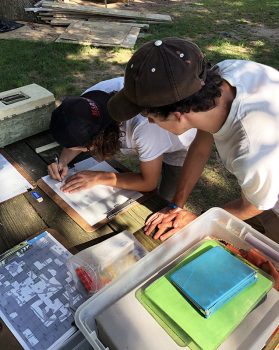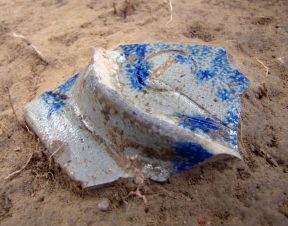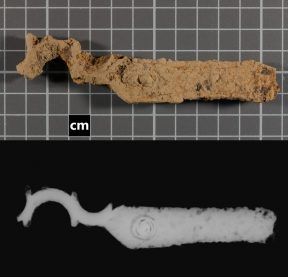Back to Dispatches from Field School
Field School 2018 – Week 6
Lucas Koenig — St. Mary’s College of Maryland
“The Week of the 4th of July”

Field school students Lucas Koenig (left) and Kyle Vanhoy hard at work on a drawing of their excavation unit
The week of the Fourth of July was a busy week at the Leonard Calvert House site! After completing the final troweling and feature photographing at the end of last week, I began this week with the next stage of documentation: mapping and soil descriptions. I, along with a couple of my peers, and under the guidance of Dr. Parno, carefully plotted and sketched the plan and profile views of the unit that I have been working on so far this summer. Documentation is key in archaeology, and along with the mapping we also completed soil color and texture descriptions. We carefully documented the precise color of every kind of soil within the unit using our standardized Munsell soil color book that we always keep handy, and were sure to be just as exact with our texture descriptions. Like all else in archaeology, our work can’t be undone, so we must diligently document everything we do before we move on. As I’ve found out this summer, digging and sifting is only about half of the work, while careful cleaning and precise documentation make up the other half. Digging into the archaeological record is like reading a book of which only one copy was made, and tearing out the pages as you go. For our work to be meaningful, we have to record what we see and what we do meticulously, and this includes the mapping and soil descriptions that occur once the digging is done.

Fragment of a North American stoneware jug with an impressed mark likely indicating that the jug was one gallon in volume
Next for me this week was jumping in on a recently started unit and once again getting back to digging. There is absolutely no way that when the Brome-Howard family put in their hard-packed gravel driveway they could have possibly imagined that, some many decades in the future, field school students would have the pleasure of carefully digging and sifting through it all. And yet, here we are. Such is life at the 2018 dig site. When someone decides to put a multi-layered gravel driveway on top of an important 17th-century colonial site, future archaeologists have to dig it back up. And then sift through it. And then keep digging through gravel to get to the plow-zone and subsoil below. Though slow to trowel, heavy in our buckets, and tedious to sift through, uncovering the Brome-Howard estate’s driveway bespeaks of the complexity of the site we’re working with. An inconvenient layer of our stratigraphy, the gravel driveway that once led to the Brome-Howard house, built in 1840 and since relocated down the road, reminds us of what it is we’re really doing: the hands-on, dirty, and heavy (sometimes very heavy) work required to uncover our past.
Wednesday was the Fourth of July and so we were off that day to honor the marking of our nation’s independence from England. As the dust settles from our celebrations, however, it is important to reflect on how the roots of our history run much deeper. Many of our nation’s highest ideals, such as Religious Freedom, can be traced to the early colonial period. More specifically, the ideal of Religious Freedom in America can be traced to Historic St. Mary’s and the Leonard Calvert House site, where its history in part lies buried beneath a hard-packed gravel driveway.
Thanks for joining us to learn more about:
Religious Freedom
The 2018 Dig Site
Documentation and Archeology





